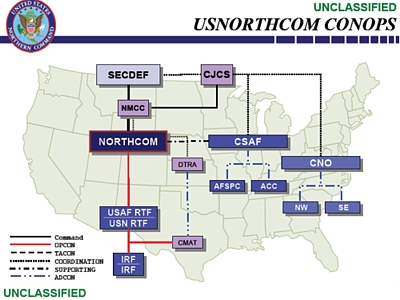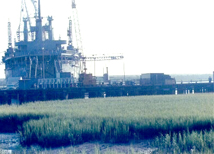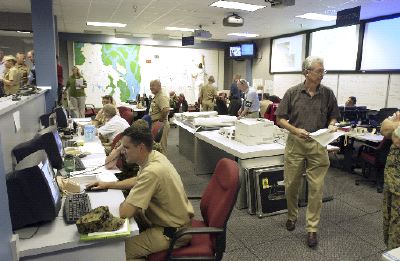Nuclear Brief February 2, 2005
 NORTHCOM
Gets Responsibility For Responding To US Nuclear Weapons Accidents NORTHCOM
Gets Responsibility For Responding To US Nuclear Weapons Accidents
The new Northern Command (NORTHCOM) has
been given overall responsibility for responding to U.S. nuclear weapons accidents in the
United States, and is preparing a new nuclear accident response plan in
coordination with the Air Force and Navy.
DOD response to
nuclear weapons accidents and incidents previously was the responsibility of all
the Unified Combatant Commands. But DOD 3150.8-M (NARP) issued on
February 22, 2005, places the overall responsibility at NORTHCOM if the
accident or incident occurs within NORTHCOM's Area of Responsibility
(AOR). According to DOD 3150.8-M (NARP):
"CDR USNORTHCOM has primary responsibility to
execute DoD response to nuclear weapon accident in the USNORTHCOM
AOR, if the weapon was in DoD custody at the time of the accident."
Under the new plan, known as NC-NARP, NORTHCOM Headquarters at Peterson AFB
in Colorado would play the following role in a nuclear weapons accident
or incident at, for example, Kings Bay:
1. A nuclear weapons accident occurs at the
Strategic Weapons Facility Atlantic (SWFLANT) at Kings Bay Naval
Base in Georgia.
2. The commander at Kings Bay sends an OPREP-3 Broken Arrow alert to
the National Military Command Center (NMCC) at the Pentagon.
3. The NMCC notifies the White House, Secretary of Defense etc. and convenes
a conference call with Operations Centers of
USNORTHCOM, the military services, JFCOM, DTRA, DHS, FEMA, DOS, DOE, DOJ
(FBI), etc.
4. NMCC dispatches a Navy IRF (Immediate Lifesaving, security & safety
controls at Kings Bay).
5. The Navy RTF (Response Task Force) is alerted and deployed to
Kings Bay.
6. NMCC gives
operational command (OPCON) of responding forces to USNORTHCOM.
7. RTF Commander is the On-Scene CDR (OSC)
and reports directly (OPCON) to USNORTHCOM (see figure).
|
New U.S.
Nuclear Weapons Accident Response Plan |
 |
|
U.S. Northern Command (NORTHCOM) has been
given primary responsibility for DOD's response to nuclear
weapons accidents in North America.
Click on image to download copy of briefing. |
According to current Navy nuclear
emergency response instructions, the estimated number of Navy personnel
forming the core of the RTF is 217. With the addition of non-Navy staff,
as many as 300 to 2,000 personnel may be involved. Security forces
include approximately 50 personnel.
Nuclear Exercises The example
of Kings Bay is not fictive. Under the code name Dingo King,
first described on William M. Arkin's website
Code Names, the DOD conducted seven nuclear weapons accident
exercises at Kings Bay between May and September 2005. The exercises are
known as Nuclear Weapon Response Exercises (NUWAX). One of these, Dingo
King 05, was held at the base from August 22-26, 2005. The scenario was:
A private plane piloted by a dentist experiencing
a heart attack crashes into a the loading dock at Kings Bay. The
crash occurs at the same time that two nuclear-armed Tomahawk
sea-launched cruise missiles (TLAM/N) are being loaded onto a
nuclear-powered attack submarine. The resultant explosion destroys
one missile and drops the second into 15 feet of water where it lays
invisibly in the mud. Was the water
contaminated by radioactive materials? Were air or land contaminated
by the explosion? Where exactly was the missile? How could the
missile be raised safely?
|
Kings Bay
Nuclear Exercise |
 |
A submarine tender simulates loading of nuclear
Tomahawk cruise missiles onto an unidentified submarine during
Dingo King 05 nuclear weapons accident exercise at Kings Bay
Submarine Base in August 2005.
Source:
Sandia National Laboratories |
The U.S. Navy stores approximately 150 nuclear-armed
Tomahawk missiles at the Strategic Weapons Facility Atlantic (SWFLANT)
on the base along with some 1,500 nuclear warheads for Trident ballistic
missile submarines. The Dingo King 05 exercise is not described on the
Kings Bay Submarine Base media web site, which does not include
press releases for 2005.
Supporting Plans To support
NC-NARP, each of the
military services with custody of nuclear weapons has developed, or is developing,
support plans. As of July 2005, this included:
- Air Combat Command (ACC) Plan 32-1, CONUS
Radiological Accident/Incident (Sep 02).
- Air Force Space Command (AFSPC) Plan 10-1, ICBM
Radiological Accident/Incident (Oct 04).
- CDR, Navy Region South East Instruction 3440.15
(Apr 05). (for Kings Bay, GA)
- Navy North West (under development). (for Bangor,
WA)
NORTHCOM's Mission
Northern Command was established in 2002
as one of many
U.S. government responses to the terrorist attacks of September 11, 2001. The command
assumed responsibilities as it achieved "initial operations capability (IOC)" on October 1, 2002,
and attained "full operations capability" on September 11, 2003.
According to NORTHCOM's website, the mission is
homeland defense and civil support, specifically:
- Conduct operations to deter, prevent, and defeat
threats and aggression aimed at the United States, its territories,
and interests within the assigned area of responsibility; and
- As directed by the President or Secretary of
Defense, provide defense support of civil authorities including
consequence management operations.
NORTHCOM's website defines homeland defense as "the
protection of U.S. territory, domestic population and critical
infrastructure against military attacks emanating from outside the
United States" (emphasis added). Yet the new responsibility
for responding to U.S. nuclear weapons accidents inside the
United States is an important addition to NORTHCOM's mission.
The new nuclear weapons accident response mission is not
described on
NORTHCOM's website.
Dingo King Versus Real-World Catastrophe
In hindsight, the timing of Dingo King 2005 is
interesting because the government's decision to assign emergency
resources to a hypothetical nuclear weapons accident exercise at Kings
Bay occurred only a few days before Hurricane Katrina slammed into New
Orleans.
|
Dingo King
05 Joint Operations Center |
 |
As Hurricane Katrina approached New Orleans in
August 2005, 1,800 government officials were busy responding to
a nuclear weapons accident that didn't happen.
Source: U.S. Navy |
Dingo King involved some 1,800 military and civilian
personnel from the Department of Defense (DOD), Department of Energy
(DOE), National Nuclear Security Administration (NNSA), Federal
Emergency Management Agency (FEMA), Federal Bureau of Investigation
(FBI), Defense Threat Reduction Agency (DTRA), Environmental Protection
Agency (EPA), National Transportation Safety Board (NTSB), and others.
The government has been widely criticized for providing
an inadequate response to Hurricane Katrina. Unlike Dingo King, the
hurricane was a real national disaster that inflicted more damage than
any nuclear weapons accident at Kings Bay probably could. Unlike in New
Orleans, where the government response was criticized for failing
miserably, the "hot wash" review after Dingo King called the
hypothetical nuclear weapons accident exercise an overwhelming success.
Said DTRA's Dingo King manager:
"The exercise demonstrated that an extremely
professional and capable emergency response team serves as the base
and local community. Dingo King was a great success."
Yet there is something surreal about the successful
Dingo King exercise in late August 2005 and the government's choice of
how to prioritize its resources as Hurricane Katrina approached. Here is
how the Sandia Lab News describe the completion of Dingo King:
"Mission accomplished, the ARG [Accident Response
Group] lifted off in a charter plane nonstop to Albuquerque on
Saturday, six days after activation [for Dingo King]. The lift-off
on Saturday afternoon was a step ahead of Hurricane Katrina, which
had by then veered toward New Orleans.
Visible in the distance and as high as the plane, the hurricane
loomed over the normal cloud layer below like the Sandias over
Albuquerque. The next morning, it would strike New Orleans, finding
terrible gaps in its preparations, despite the city's FEMA
exercises."
|

